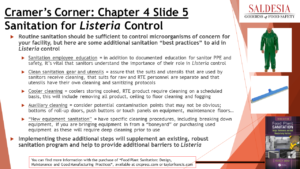Sanitation for Listeria Control
 Per Michael Cramer, “Sanitation is one of the most important, if not THE most important, parts of the food manufacturing process. it’s vital to ensure a clean environment and clean equipment, free from microbiological contaminants. With regard to Listeria control, sanitation requires multiple steps to assure the process is effective and thorough.
Per Michael Cramer, “Sanitation is one of the most important, if not THE most important, parts of the food manufacturing process. it’s vital to ensure a clean environment and clean equipment, free from microbiological contaminants. With regard to Listeria control, sanitation requires multiple steps to assure the process is effective and thorough.
Several steps for sanitation control of Listeria are presented here in Cramer’s Corner, Chapter 4 Slide 5, and in greater detail in Chapter 4 of the book Food Plant Sanitation, entitled “Control of Listeria in Food Manufacturing”.”
Slide Content
Routine sanitation should be sufficient to control microorganisms of concern for your facility, but here are some additional sanitation “best practices” to aid in Listeria control
– Sanitation employee education = in addition to documented education for sanitor PPE and safety, it’s vital that sanitors understand the importance of their role in Listeria control
– Clean sanitation gear and utensils = assure that the suits and utensils that are used by sanitors receive cleaning, that suits for raw and RTE personnel are separate and that utensils have their own cleaning and sanitizing protocols
– Cooler cleaning = coolers storing cooked, RTE product require cleaning on a scheduled basis, this will include removing all product, ceiling to floor cleaning and fogging
– Auxiliary cleaning = consider potential contamination points that may not be obvious; bottoms of roll-up doors, push buttons or touch panels on equipment, maintenance floors…
– “New equipment sanitation” = have specific cleaning procedures, including breaking down equipment, if you are bringing equipment in from a “boneyard” or purchasing used equipment as these will require deep cleaning prior to use
Implementing these additional steps will supplement an existing, robust sanitation program and help to provide additional barriers to Listeria
